Analysis of Leadership Styles and Their Impact on Organizations
VerifiedAdded on 2020/05/16
|9
|2108
|237
Essay
AI Summary
This essay delves into the critical role of leadership in modern business organizations, emphasizing the significance of democratic leadership. It begins by defining leadership and its influence on employee motivation and organizational goals. The discussion centers on Kurt Lewin's leadership styles, with a detailed analysis of autocratic, democratic, and laissez-faire approaches. The essay highlights the benefits of democratic leadership, including increased employee participation, improved communication, and enhanced teamwork. It also explores the merits and demerits of democratic leadership, such as slower decision-making processes. Core leadership values like respect, integrity, and courage are examined, with the essay concluding that effective leadership is essential for organizational success. The essay uses real-world examples and references to support its claims, providing a comprehensive overview of leadership principles and their practical application in the workplace.
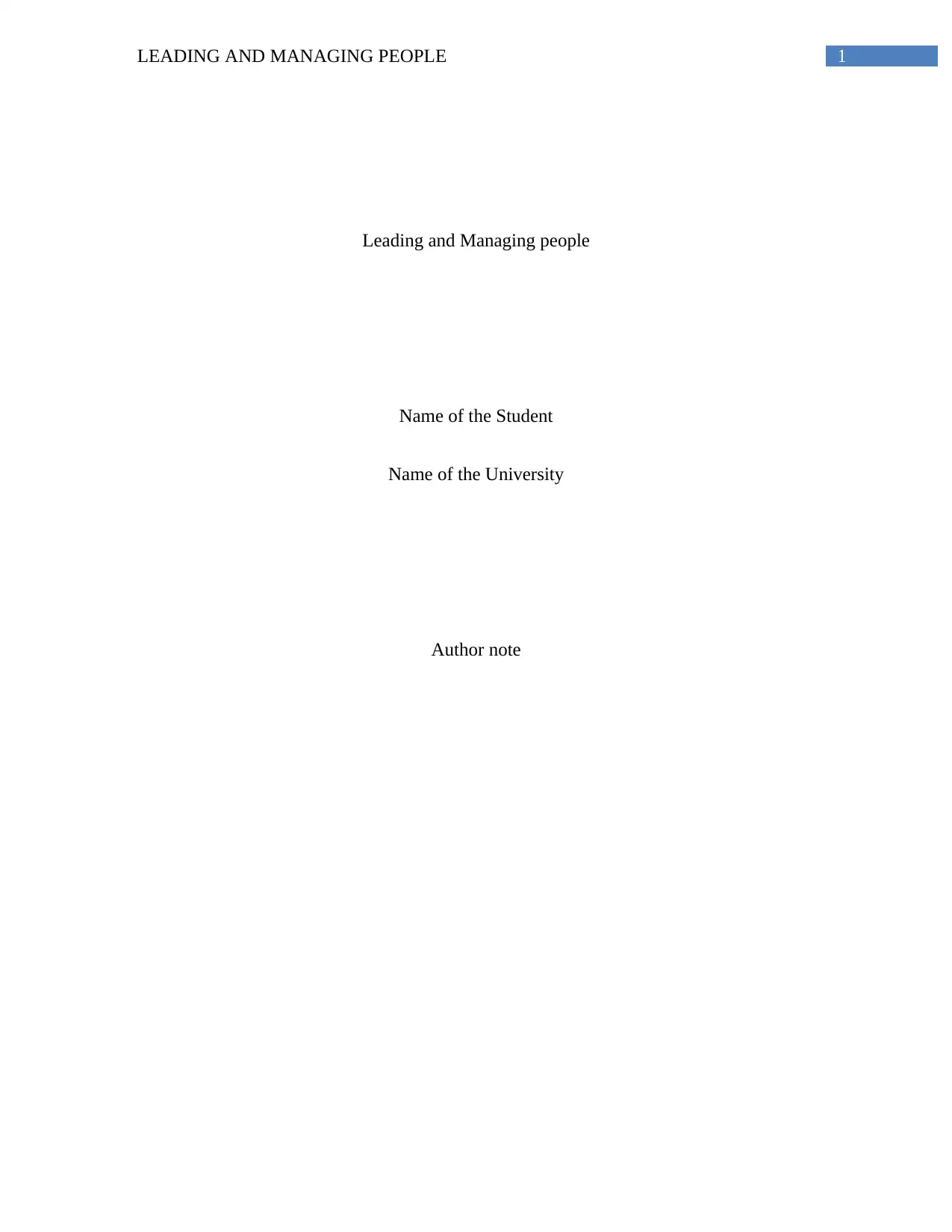
1LEADING AND MANAGING PEOPLE
Leading and Managing people
Name of the Student
Name of the University
Author note
Leading and Managing people
Name of the Student
Name of the University
Author note
Paraphrase This Document
Need a fresh take? Get an instant paraphrase of this document with our AI Paraphraser
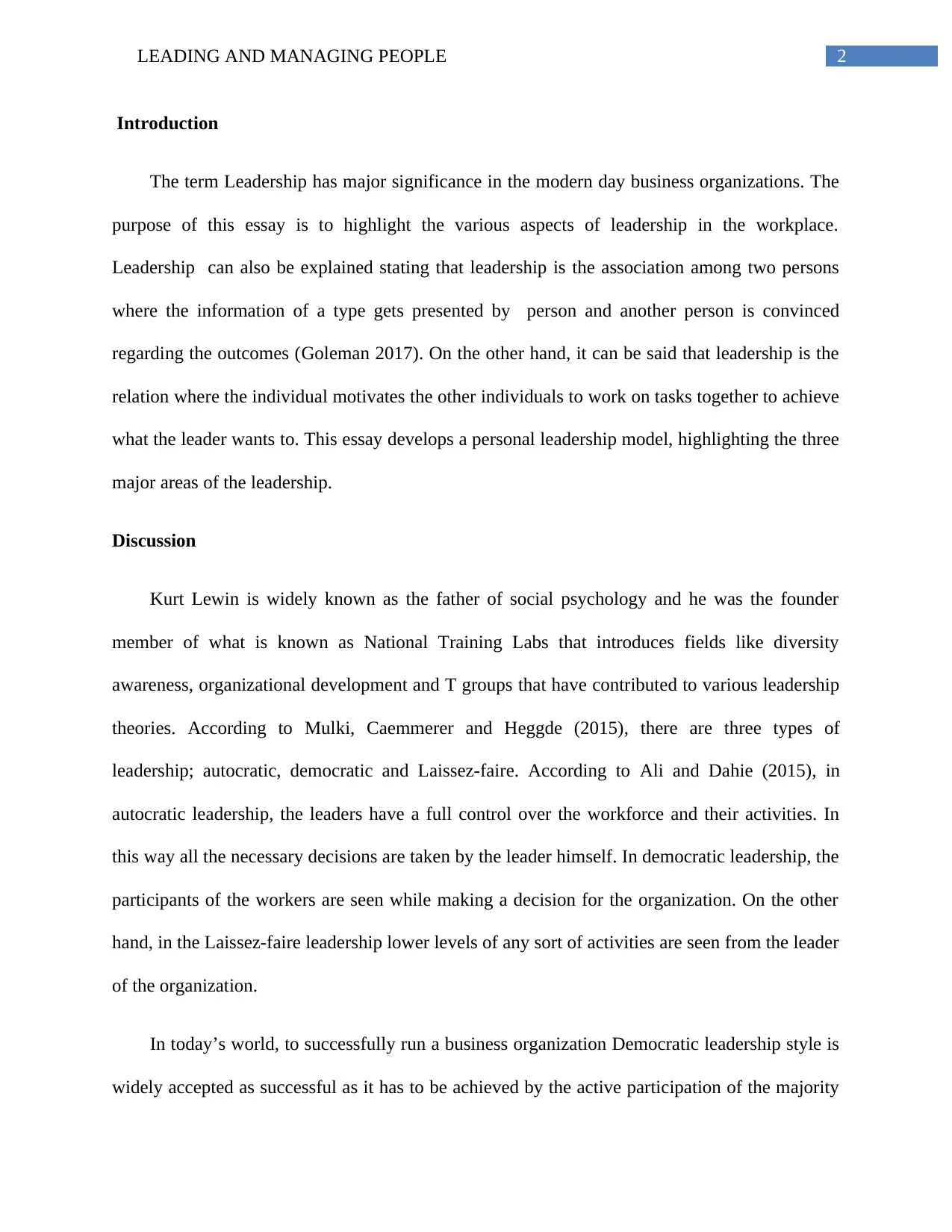
2LEADING AND MANAGING PEOPLE
Introduction
The term Leadership has major significance in the modern day business organizations. The
purpose of this essay is to highlight the various aspects of leadership in the workplace.
Leadership can also be explained stating that leadership is the association among two persons
where the information of a type gets presented by person and another person is convinced
regarding the outcomes (Goleman 2017). On the other hand, it can be said that leadership is the
relation where the individual motivates the other individuals to work on tasks together to achieve
what the leader wants to. This essay develops a personal leadership model, highlighting the three
major areas of the leadership.
Discussion
Kurt Lewin is widely known as the father of social psychology and he was the founder
member of what is known as National Training Labs that introduces fields like diversity
awareness, organizational development and T groups that have contributed to various leadership
theories. According to Mulki, Caemmerer and Heggde (2015), there are three types of
leadership; autocratic, democratic and Laissez-faire. According to Ali and Dahie (2015), in
autocratic leadership, the leaders have a full control over the workforce and their activities. In
this way all the necessary decisions are taken by the leader himself. In democratic leadership, the
participants of the workers are seen while making a decision for the organization. On the other
hand, in the Laissez-faire leadership lower levels of any sort of activities are seen from the leader
of the organization.
In today’s world, to successfully run a business organization Democratic leadership style is
widely accepted as successful as it has to be achieved by the active participation of the majority
Introduction
The term Leadership has major significance in the modern day business organizations. The
purpose of this essay is to highlight the various aspects of leadership in the workplace.
Leadership can also be explained stating that leadership is the association among two persons
where the information of a type gets presented by person and another person is convinced
regarding the outcomes (Goleman 2017). On the other hand, it can be said that leadership is the
relation where the individual motivates the other individuals to work on tasks together to achieve
what the leader wants to. This essay develops a personal leadership model, highlighting the three
major areas of the leadership.
Discussion
Kurt Lewin is widely known as the father of social psychology and he was the founder
member of what is known as National Training Labs that introduces fields like diversity
awareness, organizational development and T groups that have contributed to various leadership
theories. According to Mulki, Caemmerer and Heggde (2015), there are three types of
leadership; autocratic, democratic and Laissez-faire. According to Ali and Dahie (2015), in
autocratic leadership, the leaders have a full control over the workforce and their activities. In
this way all the necessary decisions are taken by the leader himself. In democratic leadership, the
participants of the workers are seen while making a decision for the organization. On the other
hand, in the Laissez-faire leadership lower levels of any sort of activities are seen from the leader
of the organization.
In today’s world, to successfully run a business organization Democratic leadership style is
widely accepted as successful as it has to be achieved by the active participation of the majority
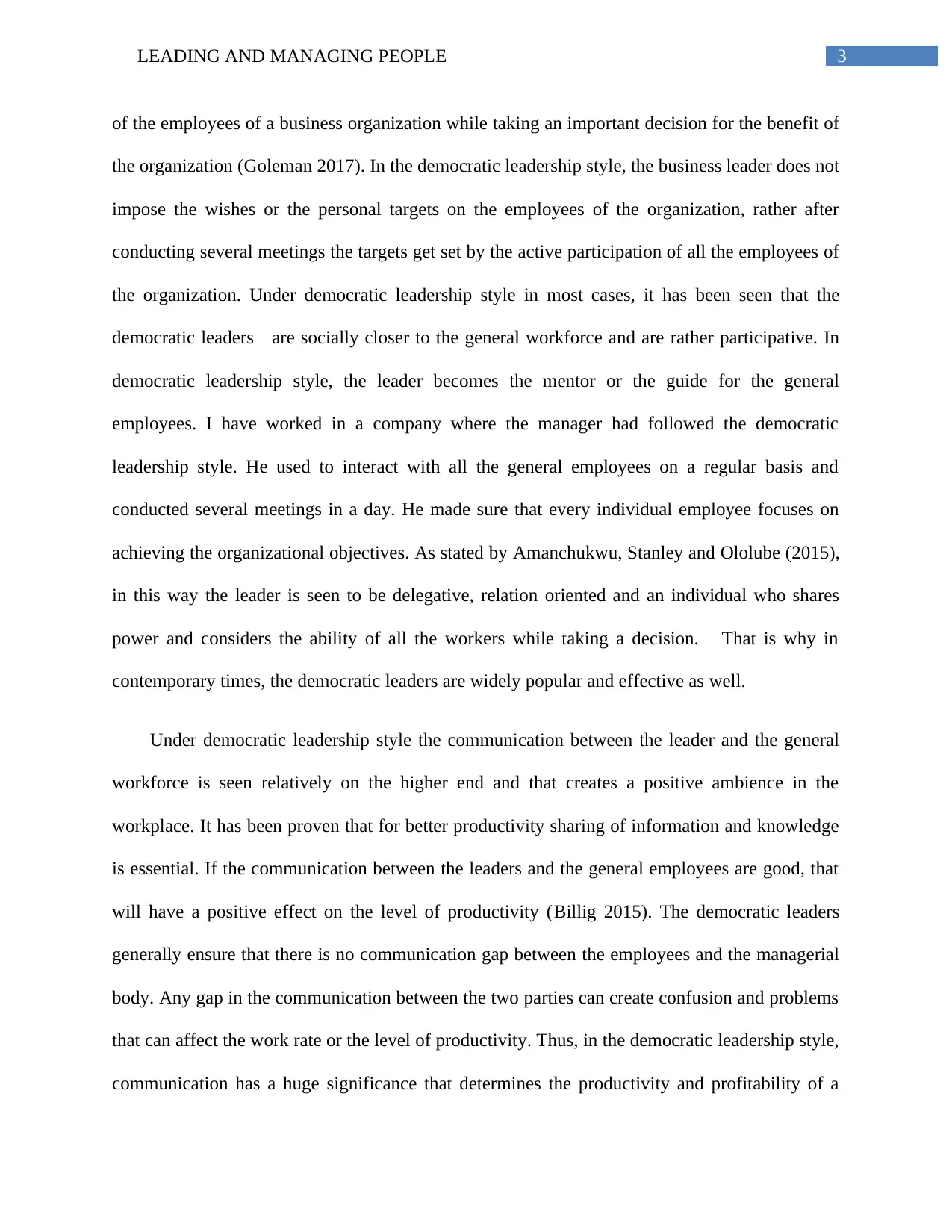
3LEADING AND MANAGING PEOPLE
of the employees of a business organization while taking an important decision for the benefit of
the organization (Goleman 2017). In the democratic leadership style, the business leader does not
impose the wishes or the personal targets on the employees of the organization, rather after
conducting several meetings the targets get set by the active participation of all the employees of
the organization. Under democratic leadership style in most cases, it has been seen that the
democratic leaders are socially closer to the general workforce and are rather participative. In
democratic leadership style, the leader becomes the mentor or the guide for the general
employees. I have worked in a company where the manager had followed the democratic
leadership style. He used to interact with all the general employees on a regular basis and
conducted several meetings in a day. He made sure that every individual employee focuses on
achieving the organizational objectives. As stated by Amanchukwu, Stanley and Ololube (2015),
in this way the leader is seen to be delegative, relation oriented and an individual who shares
power and considers the ability of all the workers while taking a decision. That is why in
contemporary times, the democratic leaders are widely popular and effective as well.
Under democratic leadership style the communication between the leader and the general
workforce is seen relatively on the higher end and that creates a positive ambience in the
workplace. It has been proven that for better productivity sharing of information and knowledge
is essential. If the communication between the leaders and the general employees are good, that
will have a positive effect on the level of productivity (Billig 2015). The democratic leaders
generally ensure that there is no communication gap between the employees and the managerial
body. Any gap in the communication between the two parties can create confusion and problems
that can affect the work rate or the level of productivity. Thus, in the democratic leadership style,
communication has a huge significance that determines the productivity and profitability of a
of the employees of a business organization while taking an important decision for the benefit of
the organization (Goleman 2017). In the democratic leadership style, the business leader does not
impose the wishes or the personal targets on the employees of the organization, rather after
conducting several meetings the targets get set by the active participation of all the employees of
the organization. Under democratic leadership style in most cases, it has been seen that the
democratic leaders are socially closer to the general workforce and are rather participative. In
democratic leadership style, the leader becomes the mentor or the guide for the general
employees. I have worked in a company where the manager had followed the democratic
leadership style. He used to interact with all the general employees on a regular basis and
conducted several meetings in a day. He made sure that every individual employee focuses on
achieving the organizational objectives. As stated by Amanchukwu, Stanley and Ololube (2015),
in this way the leader is seen to be delegative, relation oriented and an individual who shares
power and considers the ability of all the workers while taking a decision. That is why in
contemporary times, the democratic leaders are widely popular and effective as well.
Under democratic leadership style the communication between the leader and the general
workforce is seen relatively on the higher end and that creates a positive ambience in the
workplace. It has been proven that for better productivity sharing of information and knowledge
is essential. If the communication between the leaders and the general employees are good, that
will have a positive effect on the level of productivity (Billig 2015). The democratic leaders
generally ensure that there is no communication gap between the employees and the managerial
body. Any gap in the communication between the two parties can create confusion and problems
that can affect the work rate or the level of productivity. Thus, in the democratic leadership style,
communication has a huge significance that determines the productivity and profitability of a
⊘ This is a preview!⊘
Do you want full access?
Subscribe today to unlock all pages.

Trusted by 1+ million students worldwide

4LEADING AND MANAGING PEOPLE
business organization. The manager I had worked with in my previous company the manager
also made sure that there is a continuous flow of communication between the employee and the
management.
On the other hand, in the democratic leadership style due to increased communication
within the workplace, it becomes easier for the individuals who come from different cultural
backgrounds to adapt to the situations. According to Ali and Dahie (2015), in today’s world
having a workforce with people from diversified cultural backgrounds are not rare and having a
democratic leadership style in the organization promotes this type of diversified workgroups in
the organization. As in the democratic leadership style, the significance of communication is
immense, it can be said that the level of communication is equally important to sustain a
workforce having individuals from various cultural backgrounds. In this regard it is worth
mentioning that importance of communication can be applied in various areas of a workplace.
Generally the managers or the leaders, who successfully run an organization with democratic
leadership style, have great intrapersonal skills along with necessary cultural intelligence so that
he can manage a workforce that is culturally diversified (Billig 2015).
Teamwork is another important term that is used mostly in business organizations. Under a
democratic leadership, the general employees acquire the right to participate in the important
decision making for the business organization. As stated by Amanchukwu, Stanley and Ololube
(2015), apart from that, under a democratic leadership, the general employees enjoy a freedom of
choosing the way they are going to finish a task. In this regard it can be said that improving the
team bonding is important. The democratic leaders are generally inclined towards maintaining a
good communication within the workplace and that directly promote the team bonding. The
more communication is present in the workforce, the more team bonding can be seen in the
business organization. The manager I had worked with in my previous company the manager
also made sure that there is a continuous flow of communication between the employee and the
management.
On the other hand, in the democratic leadership style due to increased communication
within the workplace, it becomes easier for the individuals who come from different cultural
backgrounds to adapt to the situations. According to Ali and Dahie (2015), in today’s world
having a workforce with people from diversified cultural backgrounds are not rare and having a
democratic leadership style in the organization promotes this type of diversified workgroups in
the organization. As in the democratic leadership style, the significance of communication is
immense, it can be said that the level of communication is equally important to sustain a
workforce having individuals from various cultural backgrounds. In this regard it is worth
mentioning that importance of communication can be applied in various areas of a workplace.
Generally the managers or the leaders, who successfully run an organization with democratic
leadership style, have great intrapersonal skills along with necessary cultural intelligence so that
he can manage a workforce that is culturally diversified (Billig 2015).
Teamwork is another important term that is used mostly in business organizations. Under a
democratic leadership, the general employees acquire the right to participate in the important
decision making for the business organization. As stated by Amanchukwu, Stanley and Ololube
(2015), apart from that, under a democratic leadership, the general employees enjoy a freedom of
choosing the way they are going to finish a task. In this regard it can be said that improving the
team bonding is important. The democratic leaders are generally inclined towards maintaining a
good communication within the workplace and that directly promote the team bonding. The
more communication is present in the workforce, the more team bonding can be seen in the
Paraphrase This Document
Need a fresh take? Get an instant paraphrase of this document with our AI Paraphraser
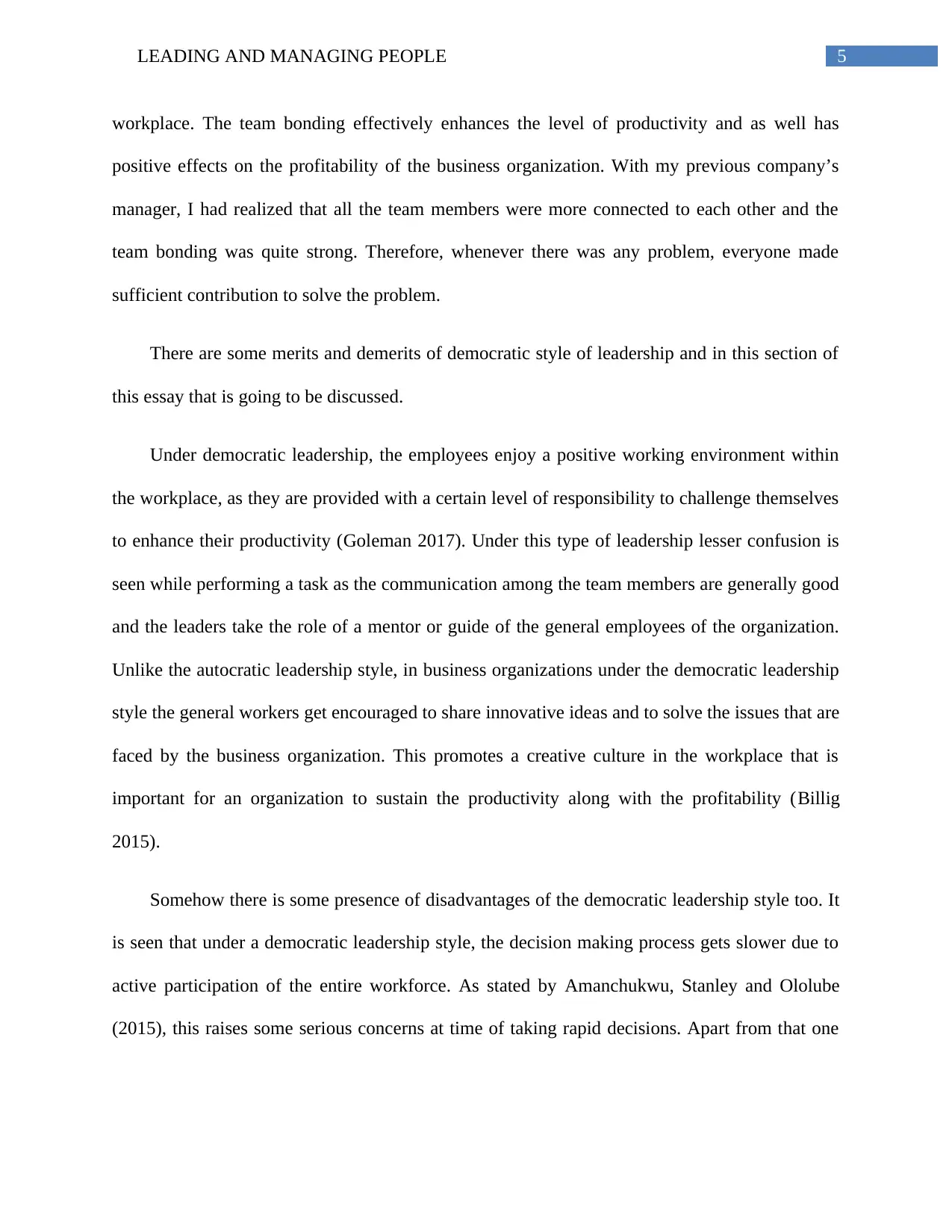
5LEADING AND MANAGING PEOPLE
workplace. The team bonding effectively enhances the level of productivity and as well has
positive effects on the profitability of the business organization. With my previous company’s
manager, I had realized that all the team members were more connected to each other and the
team bonding was quite strong. Therefore, whenever there was any problem, everyone made
sufficient contribution to solve the problem.
There are some merits and demerits of democratic style of leadership and in this section of
this essay that is going to be discussed.
Under democratic leadership, the employees enjoy a positive working environment within
the workplace, as they are provided with a certain level of responsibility to challenge themselves
to enhance their productivity (Goleman 2017). Under this type of leadership lesser confusion is
seen while performing a task as the communication among the team members are generally good
and the leaders take the role of a mentor or guide of the general employees of the organization.
Unlike the autocratic leadership style, in business organizations under the democratic leadership
style the general workers get encouraged to share innovative ideas and to solve the issues that are
faced by the business organization. This promotes a creative culture in the workplace that is
important for an organization to sustain the productivity along with the profitability (Billig
2015).
Somehow there is some presence of disadvantages of the democratic leadership style too. It
is seen that under a democratic leadership style, the decision making process gets slower due to
active participation of the entire workforce. As stated by Amanchukwu, Stanley and Ololube
(2015), this raises some serious concerns at time of taking rapid decisions. Apart from that one
workplace. The team bonding effectively enhances the level of productivity and as well has
positive effects on the profitability of the business organization. With my previous company’s
manager, I had realized that all the team members were more connected to each other and the
team bonding was quite strong. Therefore, whenever there was any problem, everyone made
sufficient contribution to solve the problem.
There are some merits and demerits of democratic style of leadership and in this section of
this essay that is going to be discussed.
Under democratic leadership, the employees enjoy a positive working environment within
the workplace, as they are provided with a certain level of responsibility to challenge themselves
to enhance their productivity (Goleman 2017). Under this type of leadership lesser confusion is
seen while performing a task as the communication among the team members are generally good
and the leaders take the role of a mentor or guide of the general employees of the organization.
Unlike the autocratic leadership style, in business organizations under the democratic leadership
style the general workers get encouraged to share innovative ideas and to solve the issues that are
faced by the business organization. This promotes a creative culture in the workplace that is
important for an organization to sustain the productivity along with the profitability (Billig
2015).
Somehow there is some presence of disadvantages of the democratic leadership style too. It
is seen that under a democratic leadership style, the decision making process gets slower due to
active participation of the entire workforce. As stated by Amanchukwu, Stanley and Ololube
(2015), this raises some serious concerns at time of taking rapid decisions. Apart from that one
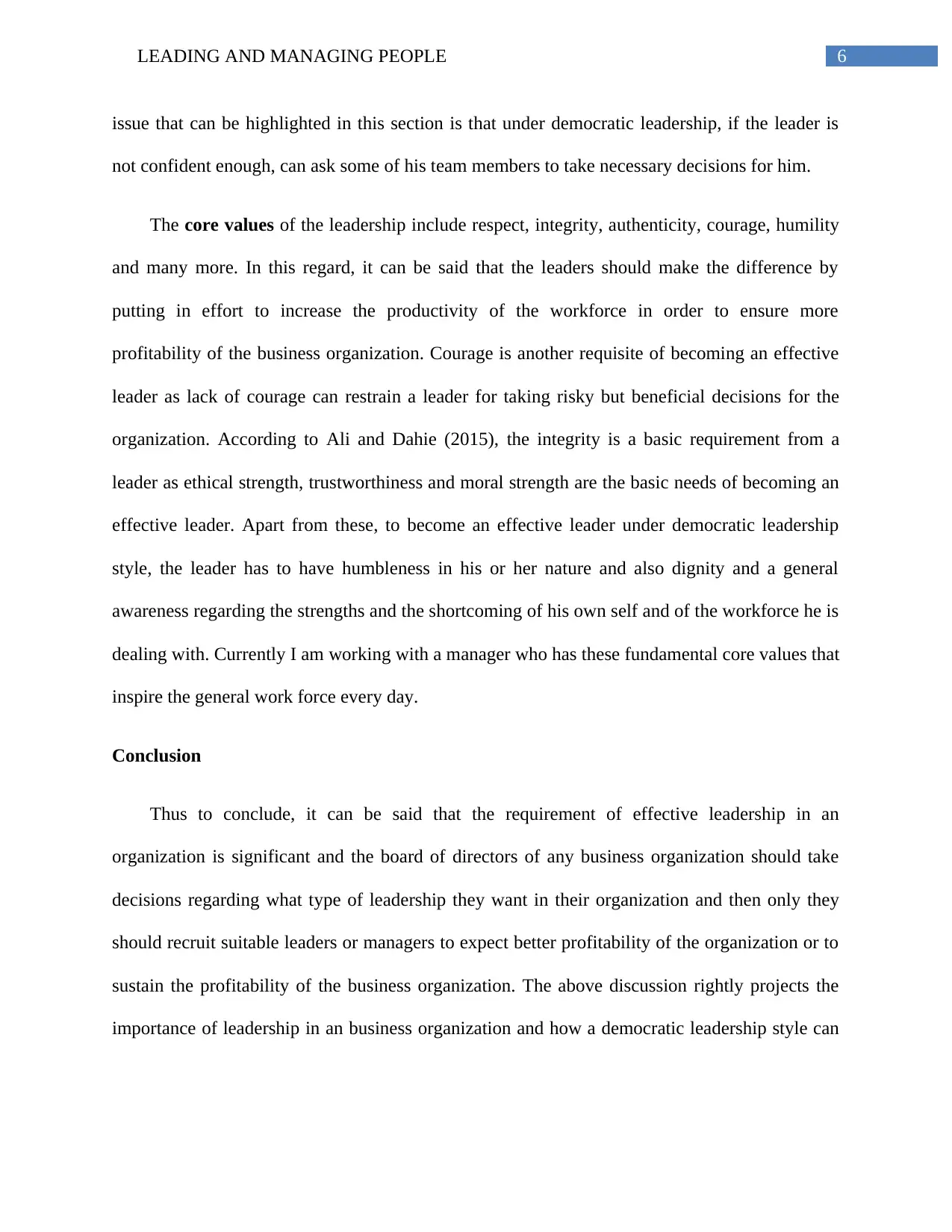
6LEADING AND MANAGING PEOPLE
issue that can be highlighted in this section is that under democratic leadership, if the leader is
not confident enough, can ask some of his team members to take necessary decisions for him.
The core values of the leadership include respect, integrity, authenticity, courage, humility
and many more. In this regard, it can be said that the leaders should make the difference by
putting in effort to increase the productivity of the workforce in order to ensure more
profitability of the business organization. Courage is another requisite of becoming an effective
leader as lack of courage can restrain a leader for taking risky but beneficial decisions for the
organization. According to Ali and Dahie (2015), the integrity is a basic requirement from a
leader as ethical strength, trustworthiness and moral strength are the basic needs of becoming an
effective leader. Apart from these, to become an effective leader under democratic leadership
style, the leader has to have humbleness in his or her nature and also dignity and a general
awareness regarding the strengths and the shortcoming of his own self and of the workforce he is
dealing with. Currently I am working with a manager who has these fundamental core values that
inspire the general work force every day.
Conclusion
Thus to conclude, it can be said that the requirement of effective leadership in an
organization is significant and the board of directors of any business organization should take
decisions regarding what type of leadership they want in their organization and then only they
should recruit suitable leaders or managers to expect better profitability of the organization or to
sustain the profitability of the business organization. The above discussion rightly projects the
importance of leadership in an business organization and how a democratic leadership style can
issue that can be highlighted in this section is that under democratic leadership, if the leader is
not confident enough, can ask some of his team members to take necessary decisions for him.
The core values of the leadership include respect, integrity, authenticity, courage, humility
and many more. In this regard, it can be said that the leaders should make the difference by
putting in effort to increase the productivity of the workforce in order to ensure more
profitability of the business organization. Courage is another requisite of becoming an effective
leader as lack of courage can restrain a leader for taking risky but beneficial decisions for the
organization. According to Ali and Dahie (2015), the integrity is a basic requirement from a
leader as ethical strength, trustworthiness and moral strength are the basic needs of becoming an
effective leader. Apart from these, to become an effective leader under democratic leadership
style, the leader has to have humbleness in his or her nature and also dignity and a general
awareness regarding the strengths and the shortcoming of his own self and of the workforce he is
dealing with. Currently I am working with a manager who has these fundamental core values that
inspire the general work force every day.
Conclusion
Thus to conclude, it can be said that the requirement of effective leadership in an
organization is significant and the board of directors of any business organization should take
decisions regarding what type of leadership they want in their organization and then only they
should recruit suitable leaders or managers to expect better profitability of the organization or to
sustain the profitability of the business organization. The above discussion rightly projects the
importance of leadership in an business organization and how a democratic leadership style can
⊘ This is a preview!⊘
Do you want full access?
Subscribe today to unlock all pages.

Trusted by 1+ million students worldwide

7LEADING AND MANAGING PEOPLE
influence the productivity of an business organization and can over all improve the state of an
organization.
influence the productivity of an business organization and can over all improve the state of an
organization.
Paraphrase This Document
Need a fresh take? Get an instant paraphrase of this document with our AI Paraphraser

8LEADING AND MANAGING PEOPLE
References
Ali, A.Y.S. and Dahie, A.M., 2015. Leadership style and teacher job satisfaction: Empirical
survey from secondary schools in Somalia. Leadership, 5(8), pp.33-29.
Amanchukwu, R.N., Stanley, G.J. and Ololube, N.P., 2015. A review of leadership theories,
principles and styles and their relevance to educational management. Management, 5(1), pp.6-14.
Bamiatzi, V., Jones, S., Mitchelmore, S. and Nikolopoulos, K., 2015. The role of competencies
in shaping the leadership style of female entrepreneurs: The case of North West of England,
Yorkshire, and North Wales. Journal of Small Business Management, 53(3), pp.627-644.
Billig, M., 2015. Kurt Lewin's Leadership Studies and His Legacy to Social Psychology: Is
There Nothing as Practical as a Good Theory?. Journal for the Theory of Social
Behaviour, 45(4), pp.440-460.
Cunningham, J., Salomone, J. and Wielgus, N., 2015. Project management leadership style: A
team member perspective. International Journal of Global Business, 8(2), p.27.
Goleman, D., 2017. Leadership That Gets Results (Harvard Business Review Classics). Harvard
Business Press.
Kiboss, J.K. and Jemiryott, H.K.S., 2014. Relationship between principals’ leadership styles and
secondary school teachers’ job satisfaction in Nandi South district, Kenya. Journal of education
and human development, 3(2), pp.493-509.
References
Ali, A.Y.S. and Dahie, A.M., 2015. Leadership style and teacher job satisfaction: Empirical
survey from secondary schools in Somalia. Leadership, 5(8), pp.33-29.
Amanchukwu, R.N., Stanley, G.J. and Ololube, N.P., 2015. A review of leadership theories,
principles and styles and their relevance to educational management. Management, 5(1), pp.6-14.
Bamiatzi, V., Jones, S., Mitchelmore, S. and Nikolopoulos, K., 2015. The role of competencies
in shaping the leadership style of female entrepreneurs: The case of North West of England,
Yorkshire, and North Wales. Journal of Small Business Management, 53(3), pp.627-644.
Billig, M., 2015. Kurt Lewin's Leadership Studies and His Legacy to Social Psychology: Is
There Nothing as Practical as a Good Theory?. Journal for the Theory of Social
Behaviour, 45(4), pp.440-460.
Cunningham, J., Salomone, J. and Wielgus, N., 2015. Project management leadership style: A
team member perspective. International Journal of Global Business, 8(2), p.27.
Goleman, D., 2017. Leadership That Gets Results (Harvard Business Review Classics). Harvard
Business Press.
Kiboss, J.K. and Jemiryott, H.K.S., 2014. Relationship between principals’ leadership styles and
secondary school teachers’ job satisfaction in Nandi South district, Kenya. Journal of education
and human development, 3(2), pp.493-509.
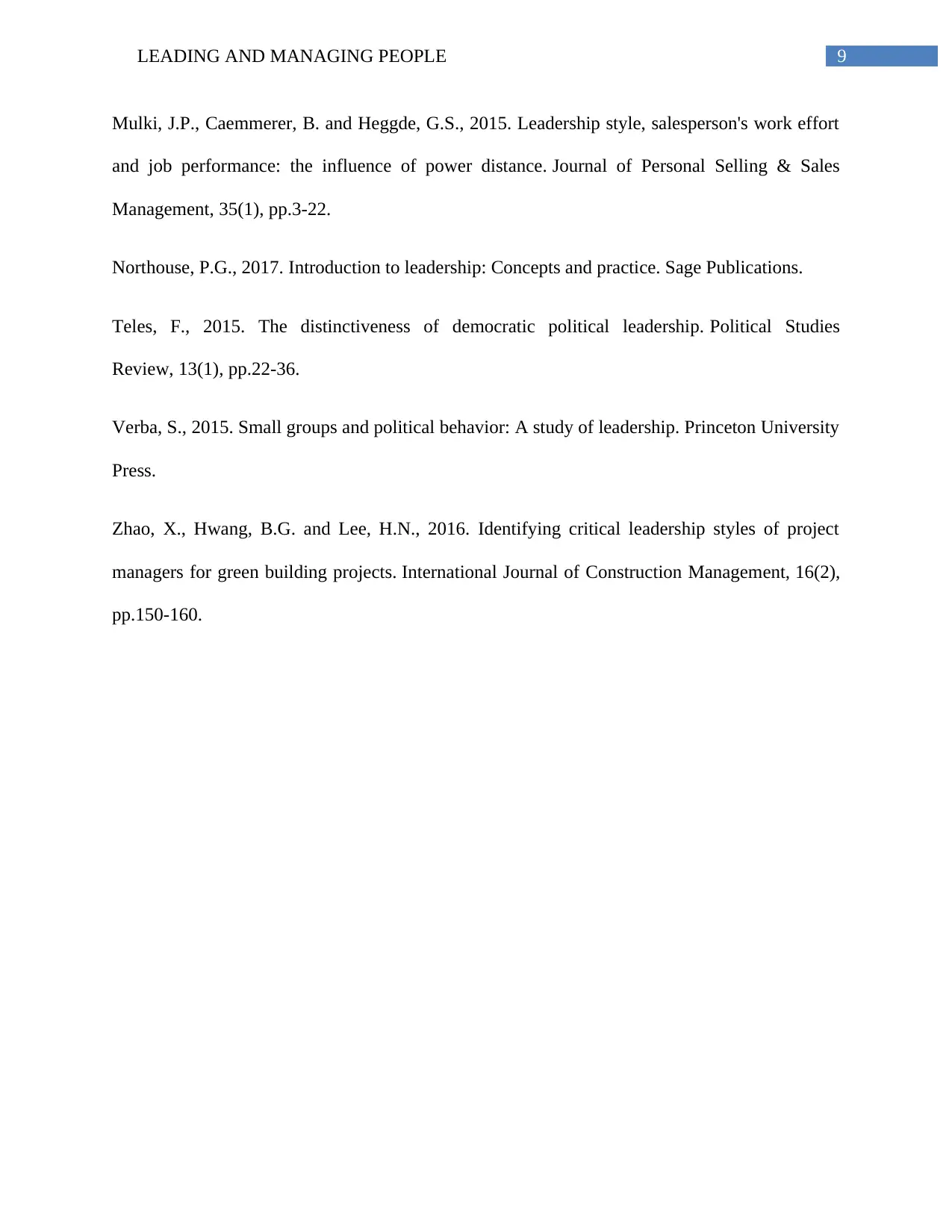
9LEADING AND MANAGING PEOPLE
Mulki, J.P., Caemmerer, B. and Heggde, G.S., 2015. Leadership style, salesperson's work effort
and job performance: the influence of power distance. Journal of Personal Selling & Sales
Management, 35(1), pp.3-22.
Northouse, P.G., 2017. Introduction to leadership: Concepts and practice. Sage Publications.
Teles, F., 2015. The distinctiveness of democratic political leadership. Political Studies
Review, 13(1), pp.22-36.
Verba, S., 2015. Small groups and political behavior: A study of leadership. Princeton University
Press.
Zhao, X., Hwang, B.G. and Lee, H.N., 2016. Identifying critical leadership styles of project
managers for green building projects. International Journal of Construction Management, 16(2),
pp.150-160.
Mulki, J.P., Caemmerer, B. and Heggde, G.S., 2015. Leadership style, salesperson's work effort
and job performance: the influence of power distance. Journal of Personal Selling & Sales
Management, 35(1), pp.3-22.
Northouse, P.G., 2017. Introduction to leadership: Concepts and practice. Sage Publications.
Teles, F., 2015. The distinctiveness of democratic political leadership. Political Studies
Review, 13(1), pp.22-36.
Verba, S., 2015. Small groups and political behavior: A study of leadership. Princeton University
Press.
Zhao, X., Hwang, B.G. and Lee, H.N., 2016. Identifying critical leadership styles of project
managers for green building projects. International Journal of Construction Management, 16(2),
pp.150-160.
⊘ This is a preview!⊘
Do you want full access?
Subscribe today to unlock all pages.

Trusted by 1+ million students worldwide
1 out of 9
Related Documents
Your All-in-One AI-Powered Toolkit for Academic Success.
+13062052269
info@desklib.com
Available 24*7 on WhatsApp / Email
![[object Object]](/_next/static/media/star-bottom.7253800d.svg)
Unlock your academic potential
Copyright © 2020–2025 A2Z Services. All Rights Reserved. Developed and managed by ZUCOL.





